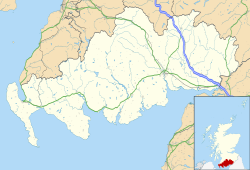| Beattock | |
|---|---|
 The Old Brig Inn, a coaching inn on the old A74 road at Beattock. | |
Location within Dumfries and Galloway | |
| Council area | |
| Lieutenancy area | |
| Country | Scotland |
| Sovereign state | United Kingdom |
| Post town | MOFFAT |
| Postcode district | DG10 |
| Dialling code | 01683 |
| Police | Scotland |
| Fire | Scottish |
| Ambulance | Scottish |
| UK Parliament | |
| Scottish Parliament | |
Beattock is a village in Dumfries and Galloway, Scotland, approximately 1⁄2 mile (800 metres) southwest of Moffat and 19 miles (31 kilometres) north of Dumfries.
Beattock was historically served by the A74 road and the West Coast Main Line, however the road has since been upgraded to the A74(M) motorway and no longer passes through the village. Beattock railway station was closed in 1972.
Beattock Summit is located approximately 10 miles (16 km) to the north of the village in the neighbouring administrative area of South Lanarkshire. At 1,033 ft (315 m) it is the highest point on both the M74, and on the West Coast Main Line within Scotland. The poet W. H. Auden's 1936 work Night Mail makes reference to the summit.
The Southern Upland Way [1] and the Annandale Way [2] run close to the village.
